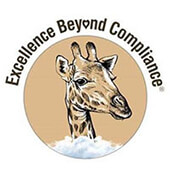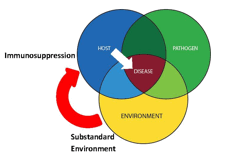Academy Contributors
 Building Blocks: Key Leaders, Self-Examination, Entrance Briefings, and Inspection Checklists Building Blocks: Key Leaders, Self-Examination, Entrance Briefings, and Inspection Checklists
By James F. Gesualdi
To keep ahead, each one of us, no matter what our task, must search for new and better methods — for even that which we now do well must be done better tomorrow.
—James F. Bell
Animal Welfare Act (AWA) compliance and zoological community professional accreditation are important contributors to progressively improving standards of animal welfare. Using the AWA and professional accreditation to constantly improve animal welfare is most effective when AWA-related processes lead to proactive practices, as part of an Excellence Beyond Compliance® program. This also aids in accreditation, as the cumulative impact produces an even better zoological organization by the time of re-accreditation. While previous columns have shown that working in concert is part of this effort, this column provides additional resources to make it work.
In addition to the CEO, two other essential leaders should be: the AWA Compliance Officer (with the authority for maintaining continuous compliance) and the Animal Welfare Officer (heading up efforts toward enhancing animal welfare). Together, they are the core of the diverse, multidepartment Animal Welfare Leadership Group (some organizations use Animal Welfare Committee) that supports AWA compliance and animal welfare. Other representatives may include: animal curators; animal caregivers, including behavioral/husbandry/training staff; an attending veterinarian; buildings and grounds staff; maintenance staff; researchers; and other staff or volunteers, as appropriate (such as a safety officer, responsible for risk management and the safety program, and representatives from outside the organization, possibly including consultants, recognized experts, and independent members). Representatives of the Animal Welfare Leadership Group should accompany your APHIS Animal Care inspector during inspections. This group should be constantly preparing to improve inspection preparation and readiness through training and regular examination and evaluation of animals and facilities. Among other things, this group also reviews and ensures that experienced personnel update policies, protocols, and practices.
A powerful way to maximize the real benefits derived from an inspection and your inspector's expertise is to conduct an entrance briefing with the help of an inspection checklist, based on AWA and accreditation standards. Once developed, this list should be continuously updated so as to always be ready for an unannounced inspection. The inspection checklist should including the following items:
- Update on corrections to any prior noncompliant items, including making available any supporting materials for "self-certified compliance reporting"
- Overview of any pertinent and applicable improvements or modifications in zoological organization activities, facilities, operations, staff, and training since last inspection
- Questions or requests for guidance from the inspector with respect to any particular situations or potential plans
- Questions for the inspector regarding any changes or updates in agency guidance or practices relevant to the zoological organization
- Any other special situations pertinent to the type of inspection being conducted (e.g., animals receiving critical care, pregnant or nursing females, new arrivals, deaths, or staff changes)
- Any areas or situations of particular interest or concern to the inspector (to be determined through discussion with the inspector either prior to or at the time of the entrance briefing).
These are but a few of more than 100 items to incorporate into your AWA compliance and animal welfare efforts or comprehensive Excellence Beyond Compliance® program. Developed, refined and successfully executed for more than a quarter of a century, these practices really work. These practices also show your extraordinary commitment to animal well-being to the agency, the public, and even your own staff, volunteers, visitors, and supporters.
© 2015 James F. Gesualdi, P.C. The opinions expressed herein are solely those of the author. This is not, nor should it be construed as, legal advice.
Please email me at jfg@excellencebeyondcompliance.com to share the good you are doing (as only you can), or with any comments or questions on this column or suggestions for future ones.
For more information on EXCELLENCE BEYOND COMPLIANCE® see the website.
To order the ebook, click here.
For upcoming workshops and sessions, contact info@excellencebeyondcompliance.com.
The Aquarium Vet Something Fishy is Going On, Part II
By Dr. Rob Jones

In my last article, we talked about the model of disease developed in 1974 by Snieszko. According to Snieszko, disease results from the interplay of three factors:
- Host
- Environment
- Pathogen
The key concept is that multiple factors are often involved in the outbreak of disease in fish. Where the three circles overlap (see diagram) is the area leading to the development of disease. It is important to explore all potential contributing factors. We have already looked at the Host and Pathogen circle; this month, we look at the Environment. As aquarists, this is the main area over which you have control.
 When considering the environment, we must first consider: where in the world did these fish or other aquatic animals come from? The type of water is obviously critical—fresh versus marine, and if it is fresh water, is it soft or hard? (There are big differences, and we can look at them more closely another time.) We then attempt to replicate that environment as closely as possible. When considering the environment, we must first consider: where in the world did these fish or other aquatic animals come from? The type of water is obviously critical—fresh versus marine, and if it is fresh water, is it soft or hard? (There are big differences, and we can look at them more closely another time.) We then attempt to replicate that environment as closely as possible.
Generally, a poor environment, for whatever reason, will place the fish under stress. The physiology of stress in fish is exactly the same as it is in us and other mammals, leading to an increase in cortisol. This occurs via the hypothalamus, pituitary gland, and interrenal cells (the fish equivalent of adrenal glands). During last month's Academy webinar, I covered this in great detail. As with humans, cortisol causes immunosuppression, which can suddenly cause typically innocuous bacteria that are normally present in the environment to cause disease and even death.
Next month, we will examine the environmental factors that can stress fish. Give some thought to this as you work with your displays in the weeks ahead. Make a list and compare it with my list next month. While water quality is definitely at the top of the list (and your list should include the parameters), there are several other important factors to consider as well.
Reference:
Snieszko, S.F. 1974. The effects of environmental stress on outbreaks of infectious diseases of fishes. J Fish Biol. 6, p. 197-208.
E-quarist™ Courses—Academy Subscriber Special!
The San Diego Zoo Global Academy is excited to share an additional Academy subscriber benefit regarding our collaboration with Dr. Jones: as an Academy subscriber, you are now entitled to a discount on the e-quarist™ courses.
For more information about the SDZGA discount, contact katrina@theaquariumvet.com.au.
Visit the Aquarium Vet website at www.theaquariumvet.com.au. |